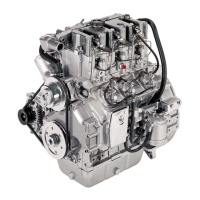R750EU5 - IE3 - TE4 - IE4 - ISE4
English 32 Ed.8 / 10-2012
GB
OPERATING INFORMATION
RECOMMENDATIONS FOR USE AND OPERATION
RECOMMENDATIONS FOR USE
Sensor (A)
The engine has been designed and
manufactured to satisfy all the operating
conditions indicated by the manufacturer.
The engine is delivered by the factory in
the running order.
However, during operation the following
indications should be observed:
1- During running-in (rst 50 working
hours) and throughout the engine lifetime,
carry out the maintenance in compliance
with the intervals established by the ma-
nufacturer. (See “Engine maintenance”)
2- Avoid using the engine at the highest
speed for prolonged periods during run-
ning- in.
3- If the engine is not regularly used, it
is advisable to start and take it to the
working temperature (70÷80°C) at least
once a month.
4- DO NOT use the engine at maximum
performances before it has reached the
working temperature (70÷80 °C).
5- When starting the engine for the rst
time, run it at no-load for a few minutes
and make sure that the oil pressure value
matches the one stated in the table. (See
“Technical data )” - “Lubrication circuit”)
6 - In the event that the ambient tempera-
ture is low during use, proceed as follow:
□ preheat the engine adequately.
□ when ambient temperatures are
lower than -10°C, contact the manufac-
turer of the vehicle regarding the instal-
lation of devices which facilitate start-up
and prevent ice forming in the engine oil
vapour recovery
Tampering with any device to achieve a
different performance from the intended
one can entail risks for people’s safety
and health as well as economic damages.
7 - Use oils and lubricants with suitable
features (viscosity grade, specications
and operating temperature). (See “Re-
commended lubricants”)
8 - If the “water in fuel” indicator lights up,
proceed as follows:
– Turn off the engine and remove the
ignition key.
– Let the engine cool down adequately to
avoid being burnt.
– Prepare a container of appropriate
capacity.
– Unscrew the water sensor (A) of the
lter and let the fuel ow until it proves to
be water-free.
– Screw the sensor (A) back.
